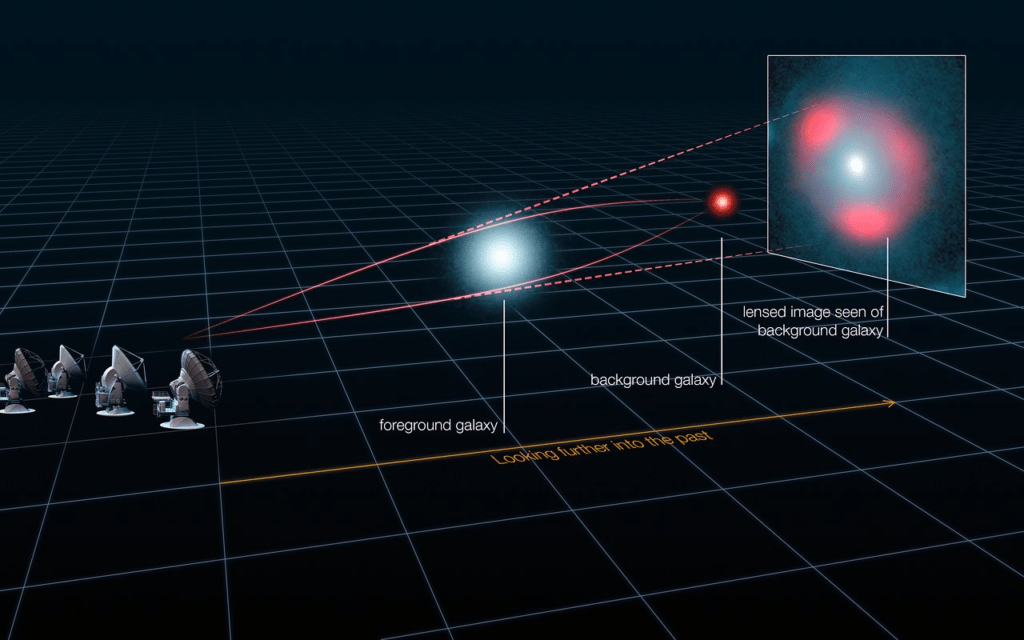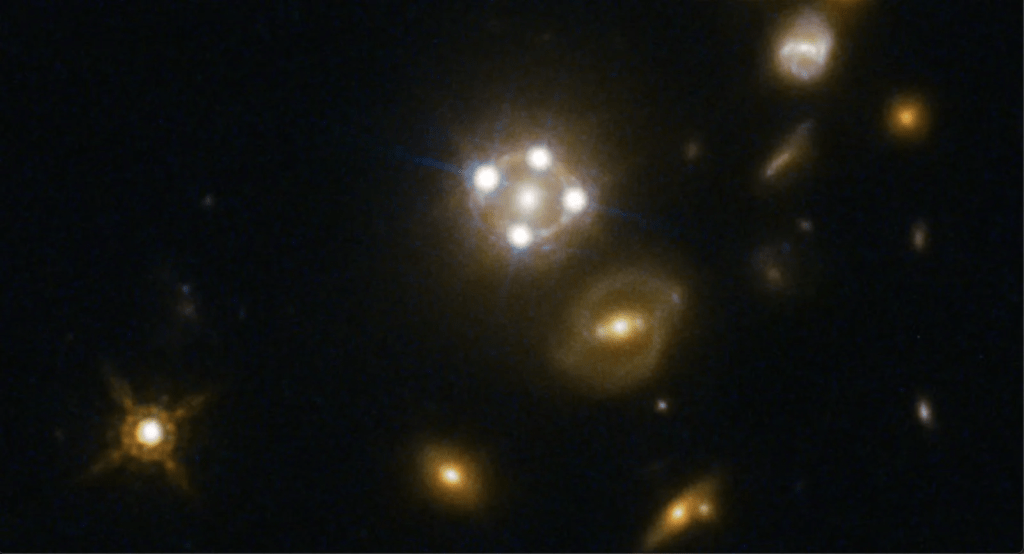Einstein’s Cross, an astronomical marvel, captivates both scientists and enthusiasts alike with its intriguing nature. Named after the legendary physicist Albert Einstein, this phenomenon presents a unique spectacle in the cosmos. In this essay, we delve into the depths of Einstein’s Cross, exploring its origins, characteristics, significance, and the profound insights it offers into the workings of the universe.
The Origins of Einstein’s Cross
Einstein’s Cross, discovered in 1979, refers to a quasar gravitationally lensed by a foreground galaxy, resulting in the formation of four distinct images surrounding the galaxy. This phenomenon is a consequence of Einstein’s theory of general relativity, which predicts that massive objects can bend the path of light. The gravitational field of the intervening galaxy acts as a lens, bending and distorting the light emitted by the quasar behind it, thus producing multiple images of the same object.
Understanding Gravitational Lensing
Gravitational lensing, a concept proposed by Einstein himself, occurs when the gravitational field of a massive object, such as a galaxy or a cluster of galaxies, bends the light passing through it. This bending effect can magnify, distort, or even create multiple images of the light source located behind the lensing object. Einstein’s Cross serves as a striking example of gravitational lensing in action, providing astronomers with invaluable insights into the distribution of mass in the universe.

Characteristics of Einstein’s Cross
Einstein’s Cross typically exhibits several distinctive features that make it a fascinating subject of study for astronomers:
- Multiple Images: The most prominent feature of Einstein’s Cross is the presence of four distinct images of the same quasar, arranged symmetrically around the foreground galaxy. These images appear as bright points of light, forming a cross-like pattern.
- Symmetry: The arrangement of the four images around the central galaxy often displays remarkable symmetry, with each image equidistant from the galaxy’s center. This symmetrical layout is a consequence of the gravitational lensing process and provides valuable clues about the distribution of mass in the lensing galaxy.
- Time Delay: Due to differences in the path length traveled by light rays from the quasar to each of its images, Einstein’s Cross exhibits a phenomenon known as time delay. This means that the light emitted by the quasar reaches each image at slightly different times, allowing astronomers to study temporal variations in the quasar’s brightness and behavior.
Significance of Einstein’s Cross
Einstein’s Cross holds significant scientific importance for several reasons:
- Probing Dark Matter: By analyzing the gravitational lensing effects observed in Einstein’s Cross, astronomers can infer the presence and distribution of dark matter within the lensing galaxy. Dark matter, an elusive form of matter that does not emit or interact with electromagnetic radiation, exerts gravitational influence on visible matter, shaping the large-scale structure of the universe.
- Testing General Relativity: The precise modeling of gravitational lensing phenomena, such as Einstein’s Cross, provides a stringent test of Einstein’s theory of general relativity. By comparing theoretical predictions with observational data, scientists can assess the validity and accuracy of Einstein’s revolutionary theory, which forms the cornerstone of modern gravitational physics.
- Cosmological Applications: Einstein’s Cross serves as a natural cosmic magnifying glass, amplifying the faint light from distant quasars and galaxies. This magnification effect enables astronomers to study distant objects with unprecedented detail and clarity, shedding light on various aspects of cosmic evolution, such as galaxy formation, starburst activity, and supermassive black hole dynamics.
Current Research and Future Prospects
In recent years, astronomers have continued to study Einstein’s Cross and similar gravitational lensing phenomena with ever-increasing precision and sophistication. Advanced observational techniques, coupled with state-of-the-art computational modeling, have enabled researchers to unravel the intricate details of lensed quasars and their lensing galaxies.

Ongoing Observations
- NASA’s Hubble Space Telescope: The Hubble Space Telescope has played a pivotal role in observing and analyzing Einstein’s Cross and other gravitational lensing systems. Its high-resolution imaging capabilities have provided unprecedented insights into the structure and dynamics of these cosmic phenomena.
- European Southern Observatory (ESO): ESO’s ground-based telescopes, such as the Very Large Telescope (VLT), contribute to the ongoing study of gravitational lensing and its implications for cosmology. Observations conducted at ESO facilities complement space-based observations, offering a comprehensive view of the universe.
Future Prospects
- James Webb Space Telescope (JWST): Scheduled for launch in the near future, the JWST promises to revolutionize our understanding of the cosmos with its advanced instrumentation and unprecedented sensitivity. Observations conducted by the JWST are expected to yield groundbreaking discoveries in the field of gravitational lensing, including further insights into Einstein’s Cross and similar phenomena.
- Square Kilometre Array (SKA): The SKA, a next-generation radio telescope currently under development, will provide astronomers with unparalleled sensitivity and resolution for studying cosmic phenomena across a wide range of wavelengths. The SKA’s capabilities are expected to significantly advance our understanding of gravitational lensing and its implications for cosmology.
Conclusion
Einstein’s Cross stands as a testament to the power of gravitational lensing in revealing the hidden secrets of the universe. Through meticulous observation and analysis, astronomers continue to unravel the mysteries surrounding this enigmatic phenomenon, shedding light on fundamental aspects of cosmology and gravitational physics. As technology advances and new observatories come online, we can expect further discoveries and insights into the nature of Einstein’s Cross and its cosmic significance.

